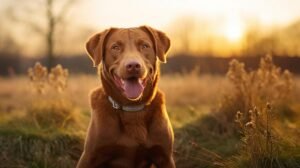Now, sit back, relax, and let’s talk about an American original – the Chesapeake Bay Retriever. What’s so unique you ask? Well, it’s the only retriever breed that originated from the good old United States of America. Christened after the Chesapeake Bay area where they were first bred, these retrievers are as American as it gets!
You see, these breeds have a long-standing history as renowned hunting companions and prove to be excellent swimmers, valiant workers and, of course, loyal family pets. However, their dense double coat, which is particularly oily and water-resistant in nature might raise a few questions for potential dog owners. Especially those who don’t fancy a house full of dog hair.
One of the most common questions asked about the Chesapeake Bay Retriever often revolves around shedding. ‘Does the Chesapeake Bay Retriever shed a lot?’ is a question many people ask before adding this breed to their family. The simple truth is yes, they do. But there is so much more to the story, and we’re going to uncover every bit of it in this blog post.
Chessies, or CBRs (as they’re lovingly known) have a uniquely designed double coat to endure freezing aquatic conditions and provide excellent camouflage. The top coat of short, thick, oily hair helps render the dog almost “waterproof.” Underneath, they have a fine, wooly and dense undercoat that provides insulation against extreme cold. This coat makes them excellent work dogs able to retrieve games during long hunts in icy water.
The slight downside to this otherwise useful double coat feature is that the Chesapeake Bay Retriever does go through two major shedding phases per year, typically during spring and autumn. This shedding is commonly known as ‘blowing coat’ where they rid their bodies of the old, dead fur to make way for fresh growth. During these periods, it may seem like your Chessie is shedding a lot!
So, how do you manage this shedding? Well, the first weapon in your arsenal is a good brush. Regular brushing helps gather loose hair before it ends up on your floor, your clothes, or (heaven forbid!) in your cupcakes. Brushing not only mitigates shedding but also keeps the oily coat of the Chessie well-balanced and healthy. It helps distribute naturally produced skin oils, helping them maintain that water-resistant attribute that makes them excellent swimmers.
Despite common folklore, shaving or excessively trimming the coat of a Chessie is not advisable. The double coat is designed specifically to keep the dog cool during hot conditions and warm in cold weather. Over trimming or shaving can destroy this natural insulation mechanism and may actually induce excessive shedding.
A nutritious diet can also help manage and minimize excessive shedding. Often, the nutrition your dog receives directly affects his coat health; insufficient nutrients may lead to excessive shedding. Premium dog foods, rich in essential fatty acids, vitamins, and proteins, promote healthier skin and in turn, a healthy coat.
One more sensible advice is to ensure your Chessie is always hydrated. Like us, hydration plays a key role in a dog’s overall health, including the health of their coat. Always make sure that fresh, clean water is readily available for your dog.
Lastly, excessive shedding can sometimes be a sign of health issues. If you notice bare patches, red or inflamed skin, or a sharper increase in shedding than the usual seasonal shed, it may be worth visiting your local vet to rule out any potential medical problems.
Remember, owning a Chesapeake Bay Retriever, or any dog for that matter, requires commitment, understanding, and a whole lot of love. Shedding is simply part of owning a dog, and with the right information and precautions, it is not merely manageable but also provides an opportunity for us to better care for our dogs. Ain’t that the extra silver lining to owning a Chessie?
In conclusion, yes, the Chesapeake Bay Retriever does shed, but that doesn’t mean you’ll be living amongst constant tumbleweeds of fur. Armed with a good brush, a balanced diet, and an eye out for potential health issues, having a Chessie as part of your family can be the fascinating, delightful experience it is meant to be!



